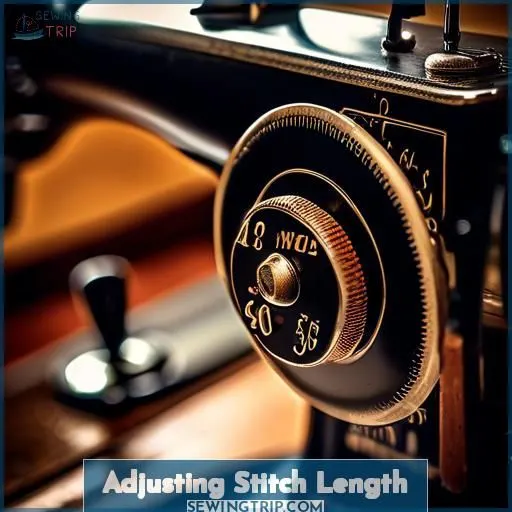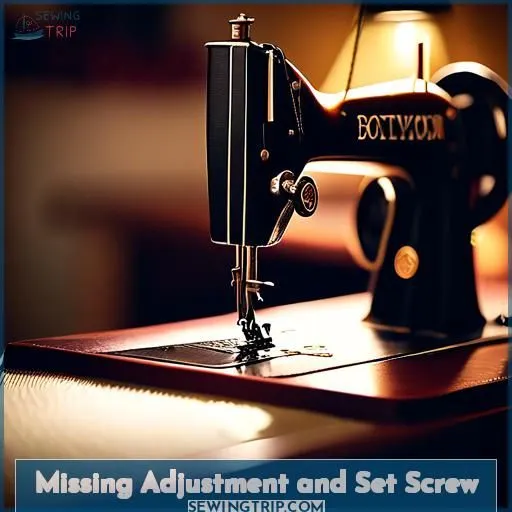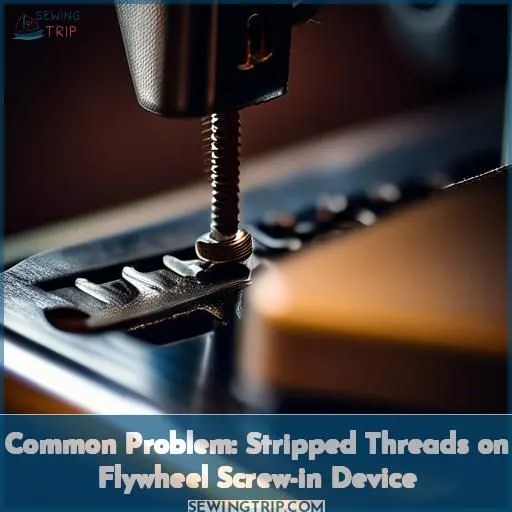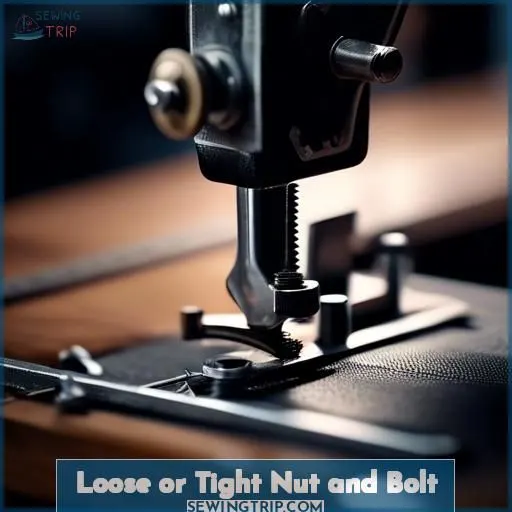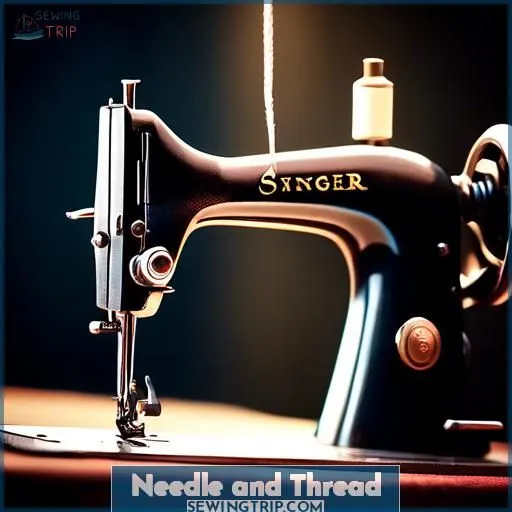This site is supported by our readers. We may earn a commission, at no cost to you, if you purchase through links.
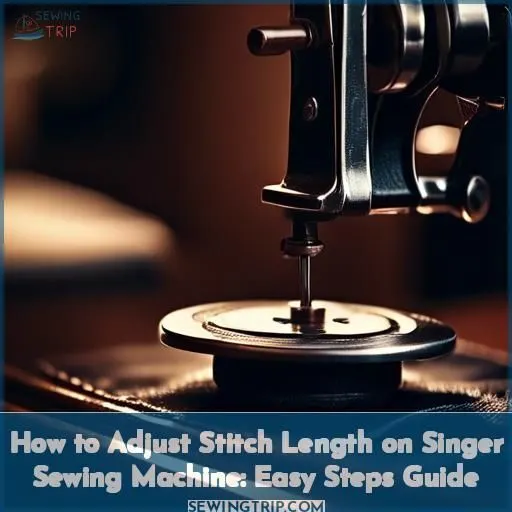
To adjust the stitch length on your Singer sewing machine, follow these steps:
Remove the top set screw on the back of the flywheel.
Locate the second set screw inside and turn it to increase or decrease the stitch length as desired.
Reinstall the top set screw and oil the moving block assembly.
Mastering stitch length adjustment allows you to achieve precise stitching for all your sewing projects.
However, if you encounter issues like missing parts or stripped threads, you’ll want to explore further techniques to keep your machine running smoothly.
Table Of Contents
Key Takeaways
- To adjust stitch length on a Singer sewing machine, remove the top set screw on the back of the flywheel and locate the second set screw inside. Turn this screw to increase or decrease the stitch length as desired.
- If you encounter issues like missing parts or stripped threads, you may need to explore further techniques to keep your machine running smoothly.
- To reinstall the top set screw, ensure you have the correct set screw size and type for your machine, remove the old set screw, and put the new one in place. Tighten it securely.
- For a wide range of replacement parts for Singer sewing machines, including rods, you can visit websites such as SewingPartsOnline, SingerOnline, or VintageSingerParts.com.
How to Adjust Stitch Length on Singer Sewing Machine?
To adjust the stitch length on a Singer sewing machine, you need to locate the screw on the bottom of the machine, near the hole in the machine. This screw regulates the stitch length. If you need to lengthen the stitch, turn the screw to the left, and if you need to shorten it, turn it to the right. Remember to test the stitch length after making adjustments and use a ruler to measure the stitch length for accuracy.
Adjusting Stitch Length
To adjust the stitch length on your Singer sewing machine, start by removing the top set screw on the back of the flywheel. Next, locate the second set screw inside and turn it to change the stitch length – clockwise increases the length, while counterclockwise decreases it.
Removing Top Set Screw
To adjust the stitch length on your Singer sewing machine, you’ll need to remove the top set screw on the back of the flywheel.
This screw is located near the stitch length lever.
It is used to access the replacement set screw source.
You can use a screw removal tool to unscrew the top set screw.
This will allow you to access the stitch length adjustment mechanism.
Adjusting Second Set Screw
To adjust the second set screw on your Singer sewing machine, follow these steps:
- Remove the top set screw on the back of the flywheel.
- Adjust the second set screw inside to change the stitch length.
- Reinstall the top set screw.
- Oil the moving block assembly.
For visual guidance, you can refer to Uwe’s video. If you’re missing an adjustment and set screw, you may need to replace the shoulder bolt with a regular bolt and nut. Contact Bob Kovar for replacement parts and call his shop on Monday.
Reinstalling Top Set Screw
To reinstall the top set screw on your Singer sewing machine, follow these steps:
- Make sure you have the correct set screw size and type for your machine. The set screw size and type can vary depending on the model of your Singer sewing machine.
- Find the set screw on your sewing machine. It’s typically located on the back of the flywheel or in the area where the flywheel meets the frame.
- Remove the old set screw using a screwdriver that matches the size and type of the set screw.
- Put the new set screw into the hole where the old one was removed.
- Tighten the set screw using a screwdriver until it’s securely in place.
- Repeat the process for any additional set screws on your sewing machine that need to be replaced.
Remember to follow the manufacturer’s instructions for your specific model of Singer sewing machine to ensure proper installation. If you’re unsure about the set screw size or type, check the sewing machine’s manual or contact the manufacturer for assistance.
Oil Moving Block Assembly
Once you’ve reinstalled the top set screw, it’s time to give your machine some TLC. A drop or two of oil on the moving block assembly will prevent it from becoming a jammed block. This bit of lubrication is like a spa treatment for your machine, ensuring the sliding regulator gib glides without hiccups, keeping your stitches sailing smoothly.
Missing Adjustment and Set Screw
If your Singer sewing machine’s stitch length adjustment is missing the set screw, you’ll need to rig it with a pin in the slot and find a suitable rod to replace the missing shoulder bolt. Contact Bob Kovar for replacement parts and be prepared to call his shop on Monday for assistance.
Machine Rigged With Pin in Slot
If your Singer sewing machine is rigged with a pin in the slot, it’s missing an adjustment and set screw.
To fix this issue, you’ll need to find a suitable rod to fit inside the hollow shaft.
Additionally, you may need to replace the shoulder bolt with a regular bolt and nut.
For replacement parts, you can contact Bob Kovar or visit his shop on Monday.
Finding Suitable Rod
To find a suitable replacement rod for your Singer sewing machine, you have several options. First, you can check out the Singer Model 27 and Model 127 parts available at Vintage Singer Parts. This website offers a wide range of genuine vintage Simanco and quality replacement parts for these models, including rods.
Another option is to browse the selection of replacement parts and accessories for Singer sewing machines at Diamond Needle Corp. They’ve an extensive inventory of parts for various models, including rods.
If you’re looking for vintage and quality replacement parts for older model Singer sewing machines, The Old Singer Shop is a great resource. They offer an array of parts, including rods, for these machines.
For a wide range of replacement parts for both home and commercial sewing machines, including Singer models, you can visit SingerOnline. They’ve a large selection of parts, including rods, and offer free shipping on orders over $20.
Lastly, if you need assistance with finding the right replacement rod for your Singer sewing machine, you can contact Bob Kovar, who’s spare and replacement parts available. He’s an expert in sewing machine repair and can help you find the perfect rod for your machine.
Replacing Shoulder Bolt
To replace the shoulder bolt on your Singer sewing machine, you’ll need to select a suitable rod.
The rod should fit inside the hollow shaft and be made of a suitable material.
Its length should match the shoulder bolt size.
Once you’ve found the right rod, remove the old shoulder bolt.
Replace it with the new one.
If you encounter skipped stitches after the replacement, adjust the check spring.
You may also need to adjust the nut and cap screw.
Contacting Bob Kovar for Replacement Parts
When you’re knee-deep in a project and hit a snag with a missing set screw or stripped threads, it’s time to contact Bob Kovar for replacement parts. He’s your go-to guru for aftermarket solutions that’ll get your machine humming again.
- Reach out to Bob Kovar for those hard-to-find parts.
- Don’t let stripped threads stall your project.
- Missing set screw? Bob’s got your back.
- Aftermarket parts can be a game-changer.
- Bob Kovar is your sewing machine’s best friend.
Calling Bob Kovar’s Shop on Monday
On Monday, you’ll be contacting Bob Kovar’s shop for substitute parts. Keep in mind, it’s vital to have the appropriate set screw for your machine’s restoration. Don’t neglect to mention the absent adjustment and set screw when you reach out to them. This way, you can guarantee a seamless and effective repair process.
Common Problem: Stripped Threads on Flywheel Screw-in Device
You might encounter a common problem where the threads on the flywheel screw-in device are stripped, making it difficult to adjust the stitch length.
In such cases, look for a long rod with a tapered end inside the machine; a cap screw holds a spring and ball bearing in place.
Unscrew the top set screw on the other side, and use a smaller set screw to adjust the stitch length.
Long Rod With Tapered End Inside Machine
If you encounter a long rod with a tapered end within your Singer sewing machine, it may be due to damaged threads on the flywheel’s screw-in device.
In this scenario, you might consider utilizing a disposable wooden chopstick or bamboo skewer as a temporary solution. You can trim it to the appropriate height with pliers and smooth it slightly with sandpaper to ensure a snug fit.
However, it’s crucial to verify that the rod isn’t worn and that the interior of the machine is clean and lubricated.
For replacement parts, you can explore websites such as Sewing Parts Online, SingerOnline, or vintagesingerparts.com, which provide an extensive selection of sewing machine components.
Cap Screw Holds Spring and Ball Bearing
If you’re having trouble with your Singer sewing machine’s stitch length, it might be due to a worn cap screw that holds the spring and ball bearing. To address this issue, you can follow these steps:
- Inspect the Cap Screw: Start by examining the cap screw to see if it’s worn or damaged. If it is, you may need to replace it with a new one.
- Check the Spring Tension: The spring tension can also affect stitch length. Make sure the spring is properly tensioned and not loose.
- Examine the Ball Bearing: Inspect the ball bearing for any signs of wear or damage. If it’s worn, you may need to replace it as well.
- Replace Worn Parts: If you find that the cap screw, spring, or ball bearing are worn, you can purchase replacement parts from a trusted supplier like Singer Online.
- Consult a Professional: If you’re unsure about the condition of these parts or need further assistance, consider contacting a professional like Bob Kovar for advice or replacement parts.
Unscrewing Top Set Screw on Other Side
To unscrew the top set screw on the other side of your Singer sewing machine, follow these steps:
- Locate the top set screw on the opposite side of the flywheel.
- Using a screwdriver, turn the screw counterclockwise to loosen it.
- Once loosened, you can remove the top set screw.
- Be careful not to lose the tapered end inside the machine.
Using Smaller Set Screw to Adjust Stitch Length
When you’re grappling with stripped threads on your Singer’s flywheel, it’s time to forge a bond with the set screw.
This diminutive powerhouse, tucked away in its secluded sanctuary, is your passport to exactitude.
Banish the notion of a universal solution; the sizing and replacement of this screw are paramount.
A deft twist here, a measured turn there, and behold, stitch length subjugated.
Bear in mind, the judicious adjustment of the set screw can weave a tapestry of wonders.
Loose or Tight Nut and Bolt
You’ll need to check the nut and bolt above the O’s on your Singer sewing machine.
These should allow some movement when adjusted.
If the nut and bolt are loose, tighten them so you can properly turn the screw to change the stitch length.
However, if they’re overly tight and won’t budge, loosen the nut and bolt first before attempting to adjust the screw.
Nut and Bolt Above O’s Should Allow Movement
To adjust stitch length on your Singer sewing machine, you’ll need to make sure the nut and bolt above the O’s allow movement. This means the nut should be loose enough to allow the bolt to move, but not so loose that it affects the tensioners. Here are some steps to follow:
- Check the nut and bolt for tightness.
- If the nut is too tight, loosen it.
- If the nut is too loose, tighten it.
- Adjust the screw to change the stitch length.
- Observe the throat plate opening and thread formation.
Checking Nut and Bolt
To check the nut and bolt on your sewing machine, you need to ensure they aren’t too loose or too tight.
If the nut and bolt above the O’s allow movement, it’s a good sign.
However, if you turn the screw and nothing changes, you should check the nut and bolt to see if they’re loose or tight.
If they’re loose, tighten them.
If they’re tight, loosen them.
Adjust the screw to change the stitch length as necessary.
Tightening or Loosening Nut and Bolt
To tighten or loosen the nut and bolt on your Singer sewing machine, follow these steps:
- Identify the nut and bolt you want to adjust.
- Use a wrench or pliers to turn the nut clockwise to tighten or counterclockwise to loosen it.
- If the nut doesn’t move, check the bolt above it. If it’s loose, tighten it. If it’s tight, loosen it.
- Once the nut is loose, you can adjust the screw to change the stitch length as needed.
Remember to be gentle and not overtighten the nut, as this can damage the bolt or other components. If you’re unsure about any of these steps, consult your sewing machine’s manual or seek assistance from a professional.
Adjusting Screw to Change Stitch Length
To adjust stitch length on your Singer sewing machine, you can use the adjustment screws located on the back of the flywheel.
These screws control the stitch length by adjusting the distance between the needle and the presser foot.
If you’re experiencing trouble with the stitch length, try tightening or loosening the thumbscrews under the pivot axle or the presser foot. This will help hold the gib securely and ensure the maximum stitch length setting is correct.
If the thumbscrews don’t improve the stitch length, you may need to troubleshoot further by wiggling the foot forward and backward or checking for wear.
Needle and Thread
To ensure proper stitch formation and avoid skipped stitches, you must use the correct needle system for your Singer sewing machine (29×3, 29×4, 135×16, or 135×17).
Fully insert the needle into the mounting clamp with the scarf facing right and the rib facing left.
Select a needle size appropriate for the thread you’re using.
Securely bond the thread to prevent unraveling.
Using Correct Needle System
Selecting the appropriate needle system for your Singer sewing machine is akin to choosing the ideal projectile for your bow—it’s vital for precision. Here’s a concise summary:
- Correlate the needle’s length and diameter with your machine’s specifications.
- Choose a needle tip that complements the fabric you’re working with.
- Verify that the needle type corresponds to your sewing requirements.
- Ascertain that the needle system is compatible with your specific model.
Inserting Needle Fully Into Mounting Clamp
To guarantee exceptional function, it’s essential to place the needle completely into the attachment clamp of your Singer sewing machine. Follow these instructions:
- Lift the Pressure Foot: Using the pressure foot lever, raise the pressure foot to reach the needle area.
- Loosen the Needle Clamp Bolt: Find the needle clamp, typically near the top of the needle bar, just above the needle. Utilize a screwdriver to loosen the needle clamp bolt by rotating it counterclockwise.
- Insert the Replacement Needle: Grasp the new needle by its stem (the upper, thicker section). Confirm that the flat side of the needle is facing the rear of the sewing machine. Insert the needle into the needle clamp, pushing it fully up until it reaches the needle stopper.
- Tighten the Needle Clamp Bolt: With your right hand, use the screwdriver to turn the needle clamp bolt clockwise to securely fasten it. Ensure it’s firm but not excessively tight, as overtightening may damage the needle or the needle clamp.
- Lower the Pressure Foot: Lower the pressure foot back into place using the pressure foot lever. This action re-establishes the tension on the upper thread.
Ensuring Scarf and Rib Are in Correct Position
To guarantee your scarf and rib are in the correct position, commence by inserting your needle completely into the mounting clamp.
Subsequently, situate the scarf on the right and the rib on the left.
This will assist in maintaining a consistent stitch length and prevent any problems with the needle or thread.
Bear in mind, the key to becoming proficient with your sewing machine lies in understanding the fundamentals and paying attention to these minor details.
Selecting Appropriate Needle Size
To select the appropriate needle size for your Singer sewing machine, consider the thread compatibility and needle sharpness.
Worn needles can cause issues with thread tension.
Always verify that the needle is completely inserted into the mounting clamp and the scarf is on the right and the rib is on the left.
Choose a needle size that corresponds to the thread you’re using.
Recall that a blunt needle can result in inferior stitch quality, so replace it when needed.
Bonding Thread Securely
To secure thread bonding, verify that your needle system (29×3, 29×4, 135×16, or 135×17) is accurate. Insert the needle fully into the mounting clamp, with the scarf on the right and rib on the left. Select the appropriate needle size for your thread. Secure the thread by following these steps:
- Thread tension: Adjust to the optimal tension for your fabric.
- Needle size: Choose a needle size suitable for your thread.
- Thread binding: Prevent thread binding by using titanium coated needles.
- Proper loop formation: Observe the hook and needle interaction for correct loop formation.
Frequently Asked Questions (FAQs)
How do I select the right type of thread?
You’ll want to match the thread’s weight and material to your project. A heavier thread like upholstery thread grips better for thick fabrics, while lightweight cotton or polyester works nicely for sheers and delicates. Check the manufacturer’s recommendations for best results.
Can I use synthetic fabrics with my Singer machine?
Ever sewn with polyester? Most Singer machines can handle synthetic fabrics just fine. You’ll want to use a stretch needle or ballpoint to avoid skipped stitches and puckering. Just go slow on trickier weaves, and you’ll be stitching beautifully in no time.
What maintenance routines should I follow regularly?
You’ll want to oil and clean your machine regularly, my friend. Check for worn parts, keep that tension balanced, and don’t forget to treat those moving pieces with some love. A well-maintained machine is a happy machine – trust me on that one.
How do I troubleshoot a noisy sewing machine?
A noisy machine often signals a lubrication issue. Don’t panic! First, oil all the moving parts. If that doesn’t quiet things down, check for worn gears or bearings. With a bit of TLC, that ol’ workhorse will be humming like new again.
Are there any specific accessories recommended for beginners?
Well, well, the enthusiastic beaver seeks guidance, eh? For starters, a sturdy pair of fabric shears and a trusty seam ripper are must-haves. But why stop there? Embrace the thrill of mastering new skills, one accessory at a time!
Conclusion
You thought adjusting stitch length on your Singer sewing machine was straightforward? Think again!
Mastering the intricacies involves more than just tinkering with set screws.
From missing parts to stripped threads, you’ll need a keen eye and steady hand to handle every curveball.
But don’t fret—this guide arms you with the know-how to tackle any how to adjust stitch length on a Singer sewing machine hiccup like a pro.

